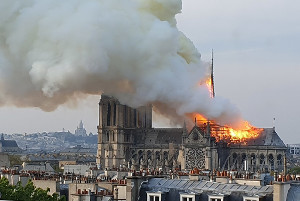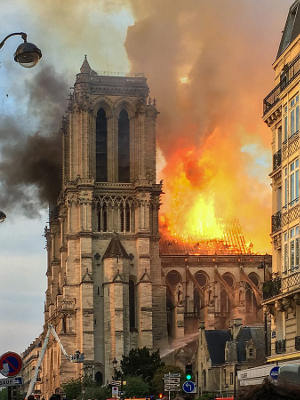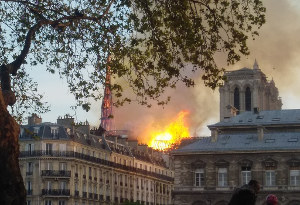Notre-Dame de Paris: a fire incident of unprecedented scale
 The Paris prosecutor's office initiated an investigation for "involuntary destruction by fire". The investigation was entrusted from the morning of 16 April to the Criminal Brigade of the Judicial Police of Paris. A staff of about 40 crime-investigating detectives was mobilized to establish the origins of the fire.
The Paris prosecutor's office initiated an investigation for "involuntary destruction by fire". The investigation was entrusted from the morning of 16 April to the Criminal Brigade of the Judicial Police of Paris. A staff of about 40 crime-investigating detectives was mobilized to establish the origins of the fire.
Notre-Dame de Paris: The damage caused by the fire
Material damage caused by the Notre-Dame de Paris fire is considerable. The iconic spire of the cathedral collapsed, the framework built from the thirteenth century and the roof, were completely destroyed. Miraculously, the large rose window, the altar and most of the works of art and liturgical objects were spared by fire.
In addition to property damage estimated at 8 billion USD, a firefighter and two police officers were injured.
Notre-Dame de Paris fire: What about the investigation?
Based on the first findings, the terrorist track has been excluded, and the most likely assumption is focused on involuntary destruction by fire.
The monumental task of collecting clues, material evidence and data has been conducted by the experts. The investigation is relying on all clues available: photos, videos, video surveillance. The objective is to determine the origin of the fire that broke out at Notre-Dame and identify the person or persons responsible for the disaster.
Once all necessary clues and leads are collected and samples taken inside and outside the cathedral, experts can analyze the data and make assumptions about the source of the fire. According to experts this step will take several weeks or even months.
First hit of the investigation: thanks to the drone used by the department of forensic identification which flew over the cathedral during the fire, the experts confirmed that the fire started at the level of the scaffolding installed on the roof of the building shortly before 19 hours before spreading to the base of the spire.
While the location of the fire has been established, the origin of the fire has not yet been known: short-circuit, "hot spot" caused by a welding torch... All scenarios are imaginable.
 Several companies were working on the site on the day of the fire
Several companies were working on the site on the day of the fire
Several separate companies, five in principle, were working on Notre-Dame de Paris. They had to do work on the frame, clean the pollution-blackened building and repair the lead blanket of the spire that had not been renovated since the 1930s.
Le Bras Frères, a company specialized in roofing and cover, expert in the renovation of cathedrals and historic monuments, won a contract for the restoration of the Notre-Dame de Paris spire at the end of 2017. At the end of a call for tenders, this SME had obtained the three loads of the assignment: scaffolding, frame and cover.
For the manager of the company Europe Echafaudage (1), subsidiary of Le Bras Frères, all the procedures and safety measures were implemented during the works. Moreover, according to this same manager, none of the company’s staff was present on the site at the time of the outbreak of the fire.
Notre-Dame de Paris fire : Insurance
The self-insurance Principle
The State is the owner of the Notre-Dame de Paris cathedral and all the works of art it houses. Until 1889, the state could rely on private insurance companies to insure its property against fire. However, given the large number and size of the property in its possession, the premium it was required to pay was considered disproportionate to any compensation it would receive in case of prejudice.
As a result, it has been decided that the State does not make recourse to insurance companies. Endowed with substantial financial resources, the State is therefore considered as its own insurer, which means that it is up to the State to take care of the damage caused by fire to its property.
This principle applies to all the cathedrals built before 1905 whose number amounts to 87. The churches built after this date belong to the dioceses and are therefore insured by insurance companies.
At this stage, the reconstruction costs of Notre Dame de Paris will therefore be borne by the State.
Related article | Insurance for places of worship
Third party liability of companies in charge of works
 It is always difficult to establish the responsibility of a company operating on a construction site because an event can occur at the time of the works or long after due to, for example, an electrical problem or a faulty connection. In addition, companies generally resort to subcontractors, which makes the task even harder.
It is always difficult to establish the responsibility of a company operating on a construction site because an event can occur at the time of the works or long after due to, for example, an electrical problem or a faulty connection. In addition, companies generally resort to subcontractors, which makes the task even harder.
TPE (Small Business) and SME (Small and Medium Enterprise) companies were present on the building site of Notre Dame de Paris the day of the outbreak of the fire. The first tasks of the investigation were aimed at establishing whether or not safety measures on the building site have been complied with.
Should the investigation find that the renovation works carried out by one of the intervening companies are at the origin of the fire, the faulty company shall be held accountable, pushing it to make use of its civil liability insurance policy, within the limits of the guarantee written. For small and medium-sized businesses, the capital underwritten is often small.
Corporate liability insurance policy covers in its basic form material damage, bodily injury and economic losses caused to third parties by the company and its employees. A third party is any natural or legal person other than the insured, that is to say, other than the company conducting works.
Additional covers may be underwritten by the insured in addition to the basic guarantee.
Read also | Assurance construction
Two of the companies operating on the site are insured by AXA, with underwritten capital not exceeding a few tens of millions of euros. These sums insured will obviously be too small to compensate for the colossal material losses caused by the fire.
Notwithstanding the principle of non-insurance by the State, the works of art and several sacred objects inside the cathedral are insured by the Archbishop of Paris to AXA Art, a subsidiary of AXA. The cathedral itself, that is, the building and its walls are not insured.
Given the extent of the damage and the small amount eventually recovered from insurance companies and "the ones held accountable" that is, the responsible companies in addition to their insurance policies, the State would be compelled to finance most of the reconstruction work. Private donations and public funds will then make up for this need for funds. In this regard, nearly one billion USD of donations were collected in a few days.
To discover: | Fine arts insurance